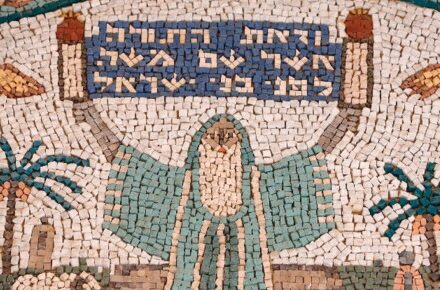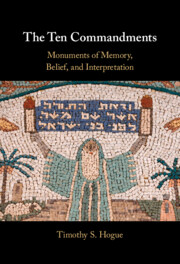
Most books about the Ten Commandments ask the question: what did they really mean? My book, The Ten Commandments: Monuments of Memory, Belief, and Interpretation, asks instead how they mean. In other words, what made them meaningful? How were they meaningful enough for the ancient Israelites to repeat the text in two places, Exodus 20 and Deuteronomy 5? Why was so much later Jewish, Samaritan, and Christian tradition devoted to interpreting those texts? Why are modern scholars and even legislators still asking questions about them? I argue that this is because the Ten Commandments are monumental.
When I say monumental, I don’t just mean that the Ten Commandments are important or large in some figurative sense. I’m using monumental in the technical sense employed by archaeologists and art historians. Monumentality is dependent on communal engagement. Monuments only mean something if people use them to make meaning. To put it differently, a monument is only meaningful when people interpret it. Otherwise, the object fails to be a monument. Just look at the Tear Drop Memorial in New Jersey. The Tear Drop Memorial is a 10-story sculpture of a falling tear that was dedicated to the American people by the Russian government to memorialize the victims of 9/11. But almost no American has actually heard of it. It meets the size expectation of monuments, it memorializes a significant event in American history, it’s aesthetically striking, and yet it’s irrelevant. It fails to mean anything, because no one bothers to interpret it.
So how did the biblical scribes make the Ten Commandments meaningful for their original audience? They did so by tapping into the expected conventions of monuments in their contemporary culture. The first indication of this is in the text itself. The Ten Commandments previously stumped scholars trying to connect them to ancient legal traditions, since they don’t share much in common with law codes. Every commandment has a parallel in Levantine monumental inscriptions, however. This is most apparent in the opening line, “I am YHWH your God who brought you out from Egypt.” This was the tell-tale sign of a monumental inscription in that historical context. We have more than 90 examples of monumental inscriptions from the region surrounding ancient Israel that open in this fashion. This was the line that inspired me to write my book 10 years ago when I switched from homework I was doing for a Northwest Semitic inscriptions class to some Hebrew reading practice. I happened to be in Exodus 20, but I was sure I had accidentally picked up a Phoenician or Moabite royal inscription. After reading these inscriptions for several weeks, you get used to their genre conventions – especially that opening “I am” statement. This was likely the experience of the original audience. When the Ten Commandments started with “I Am,” everyone knew just what sort of text it was – a monumental one.
Another strategy for making the Ten Commandments meaningful was their medium. It’s become almost passé to say that the medium is the message, but it remains true that so much of what texts mean depends on what they’re written on. Consider an example from relatively recent history: “The Declaration of the Rights of Man and of the Citizen” – the cornerstone text of the French Revolution and inspiration for the “Universal Declaration of Human Rights” now enshrined by the United Nations. Had this text merely been transmitted by word of mouth or on perishable, maligned media like toilet paper or on something mundane like a Post-it note, its reception would have been significantly hampered. A Post-it note simply does not have the same impact in our culture as something officially published, carefully ruled, and artistically presented. As it happens, many of the original iterations of “The Declaration of the Rights of Man and of the Citizen” were pamphlets designed to look like a pair of tablets modeled on traditional images of the Ten Commandments. That image lent the declaration special weight and authority by association. So another question we need to ask ourselves to determine how the Ten Commandments became meaningful is what were they written on?
It’s tempting to think this question has an easy answer. The image of a bearded Moses carrying two stone tablets down a mountain has been reiterated countless times in multifarious media from antique tile frescos to Hollywood adaptations. But not so fast. It may surprise you that this image is largely absent from the book of Exodus. Moses gets a set of tablets, yes, but the context implies that they were inscribed with the plans for the tabernacle. When he gets a second set in Exodus 34, they seem to contain a set of commandments included in the same passage – not the more famous Commandments from Exodus 20. So what were those written on?
After the Ten Commandments get proclaimed from Sinai in Exodus 20, we have to wait until Exodus 24 for them to be written down. There, we’re told that Moses set up 12 stelae and then wrote down the words of God, probably on said stelae. Why stelae? These were the most common medium for royal monumental inscriptions in the ancient Levant. This medium gave the text its weight in its original cultural context. By connecting the Ten Commandments to a set of stelae, the writer prompted his audience to relate to them in a certain way. These weren’t just some set of laws; they were a royal proclamation – an announcement of God’s kingship and a blueprint for the sort of kingdom he was setting up.
So the Ten Commandments were written on stelae, not tablets. As long as we’re talking about Exodus, that is. Deuteronomy is another story. In Deuteronomy, the Ten Commandments are very clearly written on two tablets. Why the change? Deuteronomy was written during a later period, when Assyria had become the major power in the Levant. The Assyrians constructed their empire using tablets inscribed with treaties incumbent upon their subject territories. Those tablets were installed in local temples because their words carried the authority of the gods. The stele was thus eclipsed by a new monumental medium. The biblical writers updated their depiction of the Ten Commandments accordingly, and the tradition of the two tablets was born.
In fact, the Bible imagines the Ten Commandments on a variety of media, being engaged in a variety of ways, and even with variations in their wording. The evolution of these media tells us a lot about how texts were made meaningful at different times in Israel’s history, as well as why different communities have interpreted the text in very different ways over the years. The Samaritans added an 11th commandment to inscribe the Ten Commandments on stelae, for instance, a practice they actually carried out. Early Jewish communities included the Ten Commandments in their mezuzot, apparently taking the prescription in Deuteronomy 6:9 as referring to the Ten Commandments in addition to the Shema. Some modern American communities inscribe them on stelae shaped like tablets – an unintentional amalgamation of the different traditions in Exodus and Deuteronomy.
This is just a snapshot of how the Ten Commandments have made meaning at different stages in their history. For the sake of time, I haven’t said anything about the appearance of the Ten Commandments on scrolls or amulets, for example, or about where any of these artifacts were located – another essential part of their meaning. That history is explored more fully in my book, though I confess that history was also left intentionally unfinished. That’s because the Ten Commandments continued to make meaning long after the biblical period I cover in the book. So it’s my hope that the book will prompt readers to ask how the Ten Commandments made meaning in still other contexts for different communities. The history of the Ten Commmandment’s monumentality is ongoing, and it’s one we’re still participating in today.

The Ten Commandments
by Timothy S. Hogue
Latest Comments
Have your say!